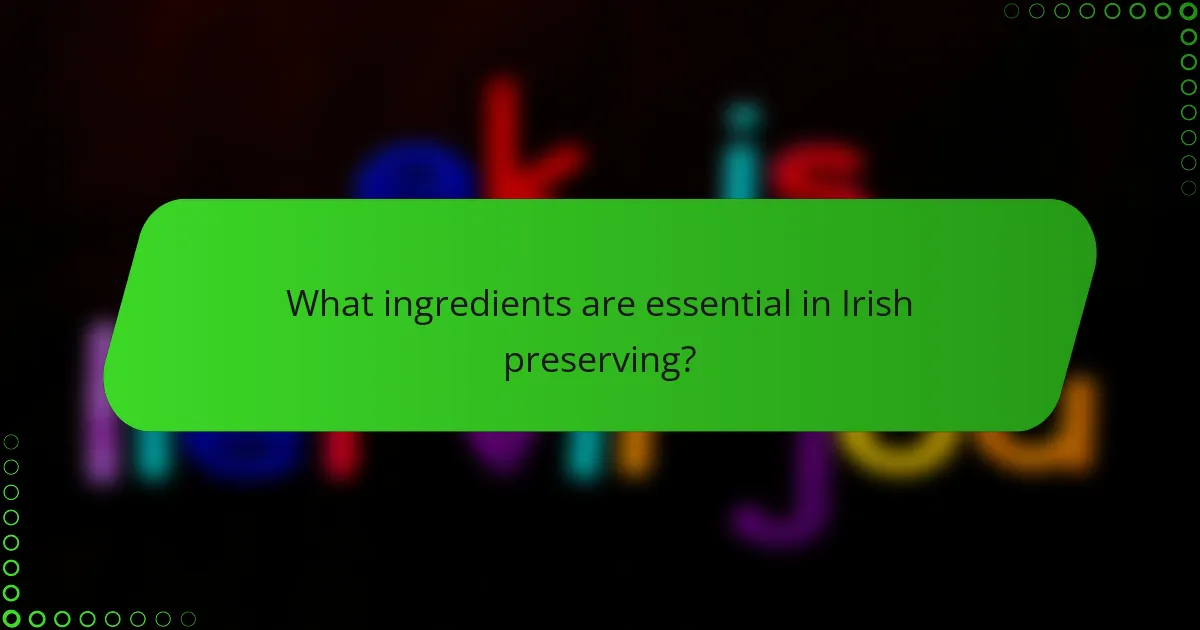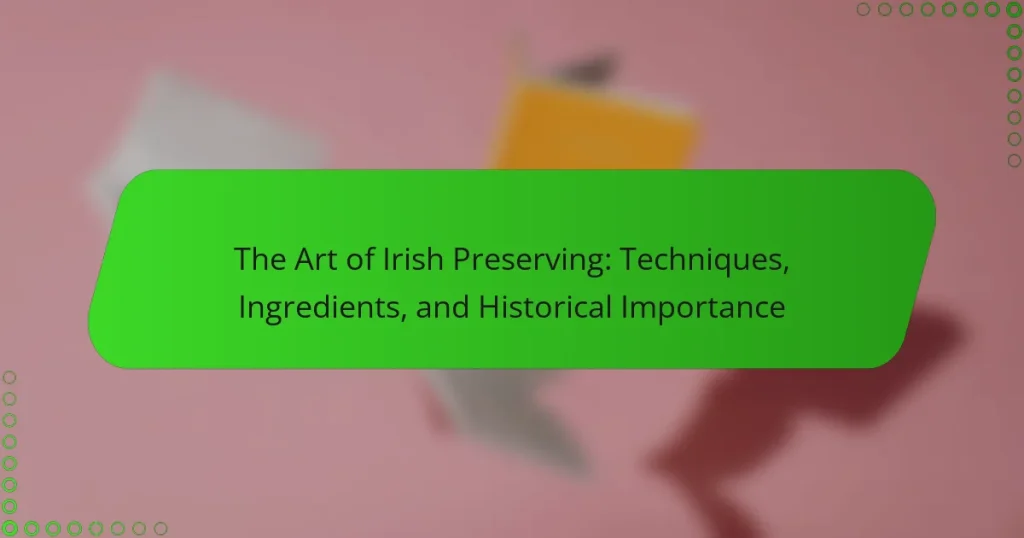The Art of Irish Preserving encompasses traditional food preservation techniques in Ireland, including pickling, fermenting, and jamming. These methods were developed to prolong the shelf life of seasonal produce, playing a crucial role in Irish culture and sustainability by minimizing food waste. Key ingredients such as sugar, vinegar, salt, and spices are essential for enhancing flavor and ensuring food safety. Today, Irish preserving is practiced in both home kitchens and commercial settings, where artisan producers focus on organic and locally sourced ingredients. Culinary schools also teach these techniques, ensuring the continuation of this vital aspect of Irish heritage.

What is the Art of Irish Preserving?
The Art of Irish Preserving is a traditional method of food preservation in Ireland. It encompasses various techniques such as pickling, fermenting, and jamming. These methods were developed to extend the shelf life of seasonal produce. Historically, Irish preserving was vital for surviving harsh winters. Ingredients often include fruits, vegetables, and spices native to Ireland. The practice reflects cultural heritage and local agricultural practices. It also promotes sustainability by reducing food waste. Today, it remains a cherished culinary tradition in Irish households.
How has Irish preserving evolved over time?
Irish preserving has evolved significantly from ancient methods to modern techniques. Initially, preservation methods included drying, salting, and smoking to extend the shelf life of food. These methods were essential for survival, particularly during harsh winters and famines. Over time, advancements in technology introduced canning and refrigeration. The introduction of sugar in the 19th century allowed for the creation of jams and jellies. Today, Irish preserving incorporates both traditional and contemporary practices. Modern techniques often emphasize organic ingredients and artisanal methods. The shift reflects a growing interest in sustainability and local sourcing. This evolution showcases the adaptability of Irish preserving in response to changing culinary trends and environmental considerations.
What historical events influenced the development of preserving techniques in Ireland?
The development of preserving techniques in Ireland was influenced by several historical events. The Great Famine of the mid-19th century created a dire need for food preservation. This led to innovations in methods to store food for longer periods. The introduction of canning in the early 19th century also impacted preserving practices. Industrialization brought access to new technologies and materials for preservation. Additionally, World War II necessitated rationing and efficient food storage techniques. The agricultural practices and seasonal harvests shaped traditional methods of preserving food. These events collectively contributed to the evolution of preserving techniques in Ireland.
How do traditional methods differ from modern approaches to preserving?
Traditional methods of preserving involve techniques such as salting, smoking, and fermentation. These methods rely on natural processes to inhibit spoilage. For example, salting draws moisture out of food, creating an environment unsuitable for bacteria. In contrast, modern approaches often utilize refrigeration, freezing, and chemical preservatives. These methods focus on extending shelf life through technology and additives. Traditional methods are often time-consuming and labor-intensive, while modern methods offer convenience and speed. Historical evidence shows that traditional preservation was essential for food security before refrigeration became widespread in the 20th century.
What are the key techniques used in Irish preserving?
The key techniques used in Irish preserving include pickling, fermenting, and drying. Pickling involves submerging food in vinegar or brine, which enhances flavor and extends shelf life. Fermenting utilizes beneficial bacteria to preserve food, often seen in traditional foods like sauerkraut. Drying removes moisture from food, preventing spoilage and is commonly used for fruits and meats. Other methods include canning, where food is sealed in jars to prevent air exposure, and smoking, which adds flavor while acting as a preservative. These techniques have been utilized for centuries in Ireland to ensure food availability during harsh winters.
How do fermentation and pickling contribute to preserving?
Fermentation and pickling are effective methods for preserving food. Fermentation uses microorganisms to convert sugars into acids, which inhibit spoilage. This process can enhance the flavor and nutritional value of food. For example, sauerkraut and kimchi are both fermented vegetables that have extended shelf lives. Pickling involves immersing food in a solution of vinegar or brine, creating an acidic environment that prevents bacterial growth. This method is commonly used for cucumbers, onions, and other vegetables. Both techniques can significantly extend the storage life of perishable items, allowing for consumption long after harvest. Historical evidence shows that these methods have been used for thousands of years to ensure food security during off-seasons.
What role does drying play in the art of preserving?
Drying plays a crucial role in the art of preserving by removing moisture from food. This process inhibits the growth of bacteria, yeast, and molds that cause spoilage. By reducing water content, dried foods can be stored for extended periods without refrigeration. Historically, drying has been used as a preservation method across various cultures, including Irish traditions. For instance, dried fruits and herbs were staples in Irish kitchens, enhancing flavor and extending shelf life. Research indicates that dried foods retain most of their nutrients, making them a valuable addition to diets. Overall, drying is an effective technique that contributes significantly to food preservation.
Why is Irish preserving culturally significant?
Irish preserving is culturally significant because it reflects the country’s agricultural heritage and resourcefulness. This practice has roots in necessity, as it allowed communities to extend the shelf life of seasonal produce. Techniques like pickling, fermenting, and drying were essential for survival during harsh winters. Additionally, preserving foods helped to minimize waste and ensure food security. Irish preserving methods have been passed down through generations, maintaining traditional flavors and recipes. This connection to history fosters a sense of identity and pride among the Irish people. The revival of these practices in modern cuisine highlights their ongoing relevance and cultural importance.
How does preserving reflect Irish agricultural practices?
Preserving reflects Irish agricultural practices by showcasing the use of local ingredients and seasonal produce. This method emphasizes sustainability and resourcefulness in food preparation. Traditional techniques such as pickling, fermenting, and drying are rooted in Ireland’s agricultural history. These practices allow for the extension of the harvest and minimize food waste. For instance, preserving fruits and vegetables during peak seasons ensures availability throughout the year. Additionally, the use of traditional recipes often highlights indigenous crops like potatoes and cabbage. This connection to local agriculture reinforces cultural identity and heritage in Irish communities.
What impact does preserving have on Irish culinary heritage?
Preserving has a significant impact on Irish culinary heritage. It helps maintain traditional recipes and techniques passed down through generations. By preserving seasonal ingredients, communities can enjoy local flavors year-round. This practice fosters a connection to the land and promotes sustainability. Historical methods like pickling and fermenting are integral to Irish cuisine. They reflect the resourcefulness of past generations in food storage. Preserving also supports local agriculture by encouraging the use of native produce. Overall, it enriches cultural identity and culinary diversity in Ireland.

What ingredients are essential in Irish preserving?
Essential ingredients in Irish preserving include sugar, vinegar, salt, and spices. Sugar is crucial for making jams and jellies, providing sweetness and aiding in preservation. Vinegar is used in pickling, creating a sour flavor while extending shelf life. Salt acts as a preservative in methods like curing meats and vegetables. Spices enhance the flavor of preserved foods, adding depth to the overall taste. These ingredients have been historically significant in Irish cuisine, ensuring food safety and longevity.
Which fruits and vegetables are commonly used in Irish preservation?
Commonly used fruits and vegetables in Irish preservation include apples, berries, and cabbage. Apples are often used for making cider and jams. Berries, such as blackberries and strawberries, are frequently preserved in jams and jellies. Cabbage is traditionally fermented to create sauerkraut. These preservation methods have historical roots in Irish culture. They were essential for food storage during winter months. The use of these ingredients reflects the agricultural practices of Ireland.
How do seasonal ingredients influence preserving choices?
Seasonal ingredients significantly influence preserving choices by dictating availability and freshness. In preserving, the peak season for fruits and vegetables ensures optimal flavor and nutrient content. For example, summer berries are often preserved as jams or jellies when they are abundant. This practice maximizes the quality of the preserved product.
Additionally, seasonal ingredients allow for varied preserving methods. For instance, vegetables harvested in autumn may be pickled or fermented. These methods enhance the shelf life and flavor profile of the ingredients.
Historical practices in Irish preserving reflect this connection. Traditional Irish recipes often utilize seasonal produce, ensuring sustainability and resourcefulness. This approach not only respects the natural growing cycles but also promotes culinary diversity throughout the year.
What herbs and spices enhance the flavor of preserved foods?
Herbs and spices that enhance the flavor of preserved foods include dill, thyme, bay leaves, and black pepper. Dill is commonly used in pickling, adding a fresh, tangy flavor. Thyme complements meats and vegetables in preservation, providing earthy notes. Bay leaves impart a subtle aroma and depth to soups and stews. Black pepper adds heat and complexity to various preserved dishes. These ingredients are often selected for their ability to infuse flavor while also possessing preservative qualities, as many have antimicrobial properties.
What preservation agents are utilized in Irish techniques?
Irish preservation techniques utilize several agents, including salt, sugar, vinegar, and alcohol. Salt is commonly used for curing meats and fish, enhancing flavor while preventing spoilage. Sugar serves as a preservative in jams and jellies, inhibiting microbial growth. Vinegar is often employed in pickling vegetables, creating an acidic environment that preserves freshness. Alcohol, particularly in the form of whiskey, can also act as a preservative in certain recipes. These agents have historical significance in Irish cuisine, reflecting traditional methods of food preservation that date back centuries.
How do sugar and salt function as preservatives?
Sugar and salt function as preservatives by inhibiting microbial growth. Sugar creates a high osmotic pressure environment. This environment draws moisture out of microorganisms, preventing their growth. Salt, on the other hand, works by dehydrating cells through osmosis. It also alters the pH level, making it less favorable for bacteria. Both sugar and salt have been used for centuries in food preservation. Historical practices include using sugar for jams and jellies, while salt has been essential for curing meats and fish. These methods extend the shelf life of food significantly.
What role does vinegar play in the preservation process?
Vinegar acts as a preservative by creating an acidic environment that inhibits microbial growth. This acidity is typically around pH 2-3, which is hostile to bacteria and molds. The acetic acid in vinegar is effective in preventing spoilage. Historical practices show that vinegar has been used for centuries in food preservation. For example, pickling vegetables with vinegar extends their shelf life significantly. Additionally, vinegar can enhance flavor while preserving food. Its role in preservation is well-documented in various culinary traditions worldwide.

What are the practical applications of Irish preserving today?
Irish preserving today is applied in various culinary contexts. It is used to create traditional foods like jams, jellies, and chutneys. Many Irish households utilize preserving to extend the shelf life of seasonal fruits and vegetables. This method enhances flavors and preserves nutrients.
In commercial settings, artisan producers craft high-quality preserves for local markets. They often emphasize organic and locally sourced ingredients. The practice also supports sustainability by reducing food waste.
Moreover, preserving techniques are taught in culinary schools as part of heritage cooking courses. This helps to pass down traditional skills to new generations. Overall, Irish preserving remains vital in both home kitchens and professional culinary arts.
How can individuals incorporate Irish preserving techniques at home?
Individuals can incorporate Irish preserving techniques at home by utilizing methods such as jam making, pickling, and fermenting. These techniques often use traditional ingredients like berries, root vegetables, and herbs. For jam making, select seasonal fruits like blackcurrants or strawberries. Cook the fruit with sugar and lemon juice until it reaches a gel-like consistency. For pickling, combine vinegar, water, and spices with vegetables such as cucumbers or cabbage. Store them in sterilized jars for preservation. Fermenting can be done with cabbage to create sauerkraut, which involves salting and allowing natural bacteria to develop over time. These methods reflect historical practices in Ireland, where seasonal produce was preserved for year-round use.
What are some beginner-friendly recipes for preserved foods?
Beginner-friendly recipes for preserved foods include pickling vegetables, making jams, and creating fruit preserves. Pickling cucumbers involves combining vinegar, water, salt, and spices. This mixture is poured over sliced cucumbers and stored in jars. The process typically takes a week for flavor development. Making jams requires fruits, sugar, and pectin. The fruit is cooked down with sugar until thickened. This mixture is then poured into sterilized jars. Fruit preserves are made similarly but with larger fruit pieces. Each method ensures long-lasting storage and enhances flavors. These recipes are accessible and require minimal equipment. They are ideal for beginners looking to explore food preservation.
What tips can ensure successful preserving outcomes?
Use fresh, high-quality ingredients for preserving. Freshness ensures better flavor and texture. Clean all equipment thoroughly to prevent contamination. Sterilizing jars and utensils is crucial in the preserving process. Follow tested recipes precisely for safety and effectiveness. Accurate measurements of ingredients affect the final product. Store preserves in a cool, dark place to maintain quality. Proper sealing prevents spoilage and extends shelf life. Regularly check for signs of spoilage, such as mold or off smells.
Why should people learn the art of preserving?
Learning the art of preserving enhances food sustainability and reduces waste. It allows individuals to extend the shelf life of seasonal produce. Preserving methods, such as canning and pickling, retain nutrients and flavors. This practice promotes self-sufficiency in food preparation. Historically, preserving has been essential for survival during harsh seasons. According to the National Center for Home Food Preservation, proper techniques can prevent food spoilage. Mastering these skills fosters a connection to cultural traditions. It also encourages creativity in the kitchen through diverse flavor combinations.
How does preserving contribute to sustainability and food waste reduction?
Preserving contributes to sustainability and food waste reduction by extending the shelf life of food. This process allows surplus produce to be utilized instead of discarded. For example, canning and pickling can prevent seasonal foods from going to waste. According to a study by the Food and Agriculture Organization, about one-third of food produced globally is wasted. By preserving food, we can save resources used in production and transportation. This practice also promotes local food consumption, reducing carbon footprints associated with long-distance food transport. Overall, preserving food effectively minimizes waste and supports sustainable practices.
What are the health benefits of consuming preserved foods?
Consuming preserved foods offers several health benefits. They can provide essential nutrients that may be lost in fresh foods over time. Preserved foods often retain vitamins and minerals, making them a valuable dietary source. For example, pickled vegetables can be high in vitamin C and probiotics. These probiotics support gut health and aid digestion. Additionally, preserved foods can have a longer shelf life, reducing food waste. This longevity means that people can access nutritious options even in off-seasons. Studies have shown that fermented preserved foods can enhance immune function. Overall, consuming preserved foods can contribute positively to a balanced diet.
The Art of Irish Preserving is a traditional food preservation method in Ireland that includes techniques such as pickling, fermenting, and jamming to extend the shelf life of seasonal produce. This practice has evolved over time, influenced by historical events like the Great Famine and advancements in technology, while still emphasizing sustainability and local agricultural practices. Key ingredients like sugar, vinegar, and salt serve as preservation agents, with commonly used fruits and vegetables including apples, berries, and cabbage. The article explores the cultural significance of preserving, practical applications today, and provides tips for individuals to incorporate these techniques at home, highlighting the health benefits and contributions to food waste reduction.


